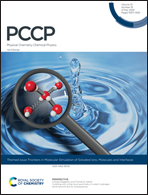Mixed uranyl and neptunyl cation–cation interaction-driven clusters: structures, energetic stability, and nuclear quadrupole interactions†
Abstract
We present a state-of-the-art quantum chemical study of mixed cation–cation interaction (CCI) driven complexes composed of uranyl and neptunyl units. Specifically, we consider the stability of the D-shaped and T-shaped structural rearrangements in CCIs, various oxidation states of the uranium and neptunium atom (V and VI), as well as a different number of unpaired electrons. Furthermore, we scrutinize the nuclear quadrupole interactions of the bare actinyl subunits and the most stable mixed CCI clusters. The electric field gradients (and nuclear quadrupole coupling constants) of neptunyls are reported for the first time. The characteristic features of the nuclear quadrupole interactions for the bare neptunyl ions are very similar to those predicted for uranyls. When the CCI clusters are formed, a considerable asymmetry is introduced compared to the bare actinyl cations. Most importantly, we are able to distinguish different types of CCIs with respect to their structural arrangement and their total charge by analyzing the electric field gradients at the uranium and neptunium nuclei.

- This article is part of the themed collection: PCCP Emerging Investigators


 Please wait while we load your content...
Please wait while we load your content...